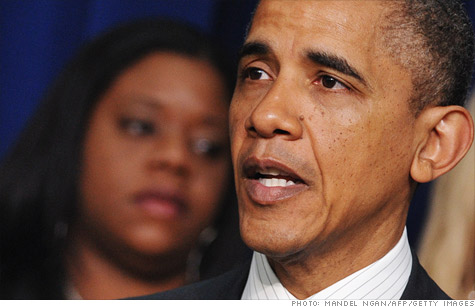
Next week, Senate Democrats will try to advance a version of Obama's Buffett Rule, which calls for millionaires and billionaires to pay at least 30% of their income in federal taxes.
NEW YORK (CNNMoney) -- President Obama on Tuesday continued to beat the drum for the Buffett Rule, his campaign-ready tax proposal aimed at millionaires and billionaires.
A central message of Obama's re-election campaign is his argument that the very rich should pay more in taxes.
"When it comes to paying down the deficit and investing in our future, should we ask middle-class Americans to pay even more at a time when their budgets are already stretched to the breaking point? Or should we ask some of the wealthiest Americans to pay their fair share?" Obama said recently.
Obama's not alone in pushing the Buffett Rule. Next week, Senate Democrats hope to vote on legislation modeled on Obama's proposal.
The legislation is not expected to advance very far, if at all. But you'll be hearing a lot about the Buffett Rule in coming months.
And like most campaign planks, the Buffett Rule doesn't necessarily make for the best policy, at least from the perspective of many tax experts.
What is the Buffett Rule exactly? The general principle behind the proposal is that millionaires and billionaires like investor Warren Buffett shouldn't pay a lower percentage of their income in federal taxes than middle-class households.
Obama has even set a threshold for how much they should pay: At least 30% of their income.
The president proposed the rule last year as a guiding principle for tax reform, and he later touted it as a replacement for the Alternative Minimum Tax.
On Capitol Hill, the Senate will hold a procedural vote on one version that would apply to today's tax code and serve as an "interim step" to tax reform.
The "Paying a Fair Share Act," introduced by Rhode Island Democrat Sheldon Whitehouse, would apply to anyone whose adjustable gross income exceeds $1 million. Those who itemize their deductions would get a credit equal to the value of their charitable contribution deductions, so as not to discourage charitable giving.
To measure whether a millionaire is paying at least 30% of his income in taxes, the bill would take into account what the individual paid in federal income and payroll taxes plus the new 3.8% Medicare surtax set to take effect in 2013.
The minimum effective tax rate would be phased in for those with incomes between $1 million and $2 million.
The independent Tax Policy Center estimates that 35% of the richest would pay higher taxes under the bill than they do today.
How much revenue would it raise? The Joint Committee on Taxation, which analyzes tax legislation, has estimated that the "Paying a Fair Share Act" would raise $47 billion over 10 years, or an average of less than $5 billion a year, assuming the Bush tax cuts expire.
That wouldn't do much to help reduce federal deficits. In recent years, annual deficits have ranged from several hundred billion dollars to more than $1 trillion.
And if the rule were to serve as a replacement for the AMT, as Obama has proposed, it wouldn't come close to making up for the $1 trillion-plus in revenue that the AMT is expected to generate over 10 years.
What do independent tax experts think of the Buffett Rule? Tuning out the partisan rhetoric on both sides, tax experts say the Buffett Rule would further complicate an already complex tax code by adding a new minimum tax on top of the old AMT.
What's more, the evidence that the Buffett Rule is correcting a big disparity in the tax code is not so clear cut.
For example, even without a Buffett Rule, most millionaires already pay more in taxes as a percentage of their income than those in the middle class, said Roberton Williams, a senior fellow at the Tax Policy Center. Not always as much as 30%, but a higher percentage of their income than the vast majority of the middle class.
And the Congressional Research Service notes that today's tax code doesn't violate the Buffett rule as egregiously as Warren Buffett and others have asserted. Using 2006 data, the CRS found the average tax rate among millionaires is almost 30% -- with about a tenth of them paying a rate higher than 35% and another tenth paying a rate below 24%.
Lastly, tax reform done right shouldn't create a need for a Buffett Rule, an AMT or any other accessory to the tax code, Williams said.
The only reason policymakers call for such measures is when they don't like the outcomes of the system they've got. Tax reform is their chance to design a better system. And if one goal is to tax the rich more, they can do that in a simpler, more effective way than the Buffett Rule. ![]()

Carlos Rodriguez is trying to rid himself of $15,000 in credit card debt, while paying his mortgage and saving for his son's college education.
| Overnight Avg Rate | Latest | Change | Last Week |
|---|---|---|---|
| 30 yr fixed | 3.80% | 3.88% | |
| 15 yr fixed | 3.20% | 3.23% | |
| 5/1 ARM | 3.84% | 3.88% | |
| 30 yr refi | 3.82% | 3.93% | |
| 15 yr refi | 3.20% | 3.23% |
Today's featured rates: